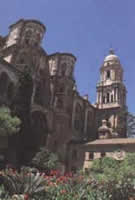Check one or more of the categories listed below to see them displayed on the map:
If you have any suggestions to new places to include in our map please click here (it only takes a couple of minutes).
Click on the icons displayed on the map for details. You can zoom in or out by using the + / - buttons at the top left corner or with the scroll feature on your mouse.
Monuments in Malaga
La Alcazaba
La Alcazaba is a military fortress build by the Moors in the 11th century on the remains of a Romans fortress. The fortress lies on a hill top with good view over the town and the sea and originally consisted of 3 protecting walls (whereas 2 are still remaining), more than 100 towers and a superior part with a residential area including 3 palaces.
Gibralfaro
The Gibralfaro Castle / Fortress is situated just next to La Alcazaba which it is connected to by ducts from two of its towers. Originally the place where the Gibralfaro lies is thought to have hosted a lighthouse build by the Phoenicians. On the remains of this lighthouse a fortress was build by Abderramn III and was later reconstructed as a castle by Yasuf I in the 14th century.
Roman Theater
The Roman Theater is located just below La Alcazaba. It was not discovered until 1951 in spite of it's size with a radius of 31 meters and height of 19 meters. Studies have shown that it hasn't been used since the 3rd century and that the Moors used elements from the Theater in the construction of La Alcazaba.

The Cathedral (see photo)
The construction of the Cathedral in Malaga began in 1528 after conquering Malaga from the Moors. It was build on the top of a former Mosque, which was destroyed when the Moors lost the town. The construction was not finished until 1782 and it therefore shows many different architectural styles such as a Gothic fundament, Renaissance facades and Baroque towers.
Sagrario Church
This Church is situated between the Palace Episcopal and the Cathedral.
It was build on the ruins of the major Arab mosque in the 15th century in a gothic style. Inside the church there is a fascinating altar build Juan de Balmaseda.
Santiago Church
The Santiago church, situated in calle Granada, was constructed in the 16th century in a mixture of Gotic and Mudjar (Arab) style. This was also the church were Pablo Picasso was baptized.
Palace Marqus de Valdeflores
This palace was constructed in the 18th century as an exhibition hall for the Malagueos but was later acquired by a noble family in 1895 for personal premises. In 1986 it was bought back by the government and today hosts different associations.
Palace Episcopal
This palace is situated next to the cathedral and is considered to represent the typical Malagueean architectural style from the 18th century. Today the Museum Diocesano is hosted in the palace.
Palace de la Aduana
Today this palace, build in neo-classic style in the 18th century, serves as the headquarters for the regional government. The palace also hosts a smaller exhibition hall.
The Town Hall
The town hall was build between 1912 and 1919 and is one of the most remarkable modernistic buildings in Malaga.
The House of the Consulate
The house of the consulate, which is situated on Plaza de la Constitucion, was build in the 18th century in a neo-classic style and is today declared a national historical monument.
Malaga Bullfighting Ring
The bullfighting ring in Malaga is from 1874 and has a total capacity for about 15.000 people.